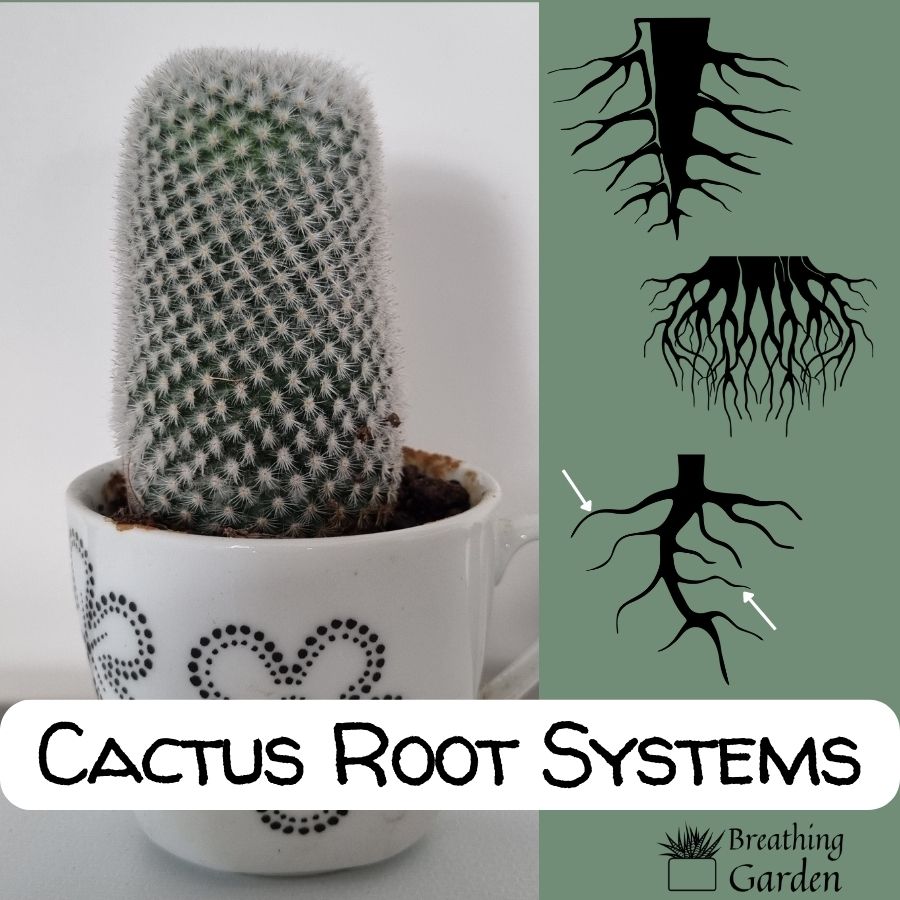Do cacti have roots? The answer is yes, they do! Cacti are a type of succulent, and they have unique root systems that helps them survive in arid environments. In this post, we will discuss the different types of cactus roots systems, and how they help these plants thrive in drought conditions.
*This post may include affiliate links. When you purchase items from these links, we will receive a small commission, at no extra cost to you, to help support this website. Thank you for your support! Read more ->
The roots of cacti, like other plants, serve several purposes. They help to anchor the plant in the ground and provide water, oxygen, and nutrients from the soil. The roots also store extra moisture in times of drought. Depending on the variety of cacti and where they grow in the wild, the size and shape of their root systems can vary.
Let’s delve deeper and look at these root systems!
Do Cacti Have Roots?
Yes, cacti do have roots! About the only plants you’re likely to see without roots are air plants (which can actually have roots!) or moss. Like with many other plants, the types of roots vary depending on the plant, and how they can best function in conjunction with the above ground cactus.
Cactus Root Systems
Why The Root Systems are the Way They Are
Cacti have evolved to survive in arid and desert regions, with little rainfall. Because of this, they’ve developed a unique root system that allows them to thrive in these kinds of environments. This root system typically has most roots close to the surface of the soil with some roots extending deep into the ground.
The shallower parts of the root system absorb moisture from the surface, while the deeper parts search for any moisture that may be found further below. Three of the main kinds of roots you’ll find on a cactus can include taproots, fibrous roots, and lateral roots.
Cactus Roots: Taproots

The easiest way to picture taproots are to think of carrots or other root vegetables. Or picture it if you’ve ever yanked a dandelion out of the ground. These plants grow with one main root below the ground, that holds most of the moisture for the plant.
Cacti, however, don’t have this type of root system. Taproots are usually only found in plants that need a lot of support to stay upright. Not all cacti have this type of root system, but some do!
Cactus Roots: Fibrous Roots

Fibrous roots are probably the most common type of root system that cacti have. It’s a type of root system that helps the cactus absorb water quickly. This is because fibrous roots consist of many small, shallow roots that spread out rather than down. If you’ve ever taken a cactus out of the soil, this is what you’re most likely going to be seeing.
They absorb water quickly and are able to search for moisture in the soil, which helps the cactus survive in a dry environment. This is because not many larger roots go deep into the soil, but instead have a bunch of spindly roots close to the surface.
This is also why they are found in plants that survive in arid climates, and how they cacti can thrive in smaller containers and pots than most other houseplants.
You may be interested in: Why is my cactus falling over?
Cactus Root Systems: Lateral Roots

Regardless of the above type of roots your plant mainly has, it’s likely going to have lateral roots. These will branch out from the main roots.
Lateral roots get their name from the direction they grow, which is outward and away from the center of the plant. These roots can be several inches to a few feet long, depending on the variety of cactus and where it’s growing. Lateral roots are essential for cacti, as they help the plant absorb moisture when water is scarce in its natural habitat.
These can also lend to stability of the plant, since they can be spread out in a wide network and help anchor the cactus into the ground.
Caring For Your Cactus Roots
Now we’ve discussed what types of roots can be on cacti, how do you care for them? There’s really not a lot you have to do! The biggest issue with cactus roots is if they get overwatered. This can lead to root rot, which is why you generally want to water your cacti less often than most other houseplants.
(Root rot can cause your cactus to turn black!)
It’s important to not have your cactus in too deep of a pot either, or else the potting soil can become too soggy. Make sure you check your cactus for signs of root rot if you suspect it’s been overwatered.
Can you Trim Cacti Roots?
You can trim cactus roots, but you don’t necessarily need to. Since they’ve got a small root system already, if you’re planting on repotting the cactus, none of the roots should need to be trimmed down.
The only time I would suggest trimming cacti roots is if they have gotten root rot. In that case, you would need to cut off any rotted roots. Otherwise, just let the plant’s root system do its thing!
Succulent Roots
While all cacti are succulents and not all succulents are cacti, it’s important to talk about them here too. They can have the same root systems as cacti, but are more likely to also have aerial roots. These can be a sign of a problem with your plant, or it can just be them trying to expand into new territory!
Do Cacti Have Roots? In Summary
To summarize, cacti do have roots! They typically have shallow fibrous roots that spread out near the surface. As well as lateral roots that can grow outward and help to anchor the plant. While some cacti may have taproots, this is not common in most varieties. The way cacti root systems are structured helps them absorb water quickly and make the most of their environment.
When it comes to caring for your cactus roots, it’s best to not over-water your plant and make sure the pot isn’t too deep.
Good luck and happy gardening!



